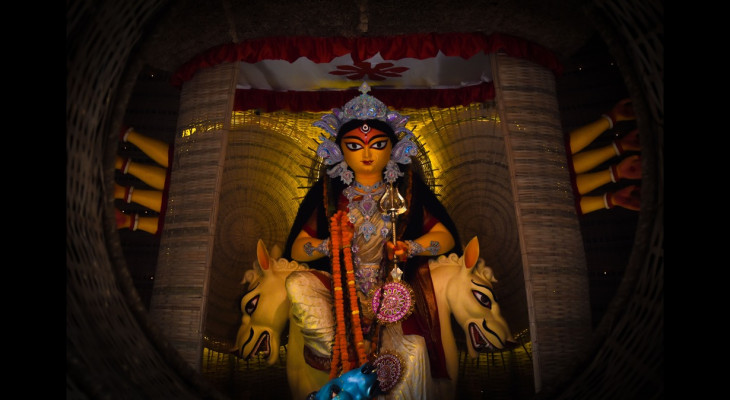Bharat is a land rich in culture and tradition! From vibrant dance forms of Kuchipudi, Bharatanatyam and Khatak to sparkling festivals like Holi, Diwali and Navratri, there is so much to experience and appreciate. As the bright festival of Shardiya Navratri knocks on the doors, the devotees of Maa Durga are ready to deep dive into the devotion of this auspicious nine-day festival. The festival of Navratri comes four times a year: Chaitra Navratri, Shardiya Navratri, Magha Navratri and Ashadha Navratri. However, Chaitra and Shardiya Navratri are widely celebrated throughout the nation, but the Navratri of Magha and Ashadha are celebrated as the Gupt Navratri. The advancing shardiya Navratri celebrated from the pratipada to the navmi of Ashwin Shukla Paksha of Hindu calendar.
Shardiya Navratri is named after Sharada, which means autumn. It begins on the first day of the bright fortnight (pratipada) of the month of Ashwin. The festival is celebrated for nine nights once a year during this month, which usually falls in the Gregorian months of September and October.
|
Date |
Puja |
Navratri |
|
October 15 |
Ghatasthapana |
Maa Shailputri |
|
October 16 |
Brahmacharini Puja |
Maa Brahmacharini |
|
October 17 |
Chandraghanta Puja |
Maa Chandraghanta |
|
October 18 |
Kushmanda Puja |
Maa Kushmanda |
|
October 19 |
Skandamata Puja |
Maa Skandamata |
|
October 20 |
Katyayani Puja |
Maa Katyayani |
|
October 21 |
Saraswati Puja, Kalratri Puja |
Maa Kalratri |
|
October 22 |
Durga Ashtami, Mahagauri Puja |
Maa Mahagauri |
|
October 23 |
Maha Navami |
Maa Siddhidatri |
Nine forms of Durga
1. Maa Shailputri
Pratipada, also known as the first day, is associated with the form of Shailaputri (“daughter of the mountain”), an incarnation of Parvati. It is in that form that Durga is worshipped as the daughter of Himavan (the guardian deity of the Himalayas). She is depicted riding the bull Nandi, holding a tricycle in her right hand and a lotus flower in her left.
2. Maa Brahmacharini
Dwitiyana (second day) Goddess Brahmachari, another incarnation of Parvati, is worshipped. In this form, Parvati became Yogini, her unmarried self. Brahmachari is worshipped for bestowing liberation or moksha and peace and prosperity. She is depicted walking barefoot and holding a japamala (prayer) and a kamandala (pot). She symbolizes happiness and peace.
3. Maa Chandraghanta
Tritiya (the third day) marks the worship of Chandraghanta, the name derived from the fact that Parvati, after her marriage to Shiva, adorned her forehead with an ardhachandra (literally crescent moon). She is the epitome of beauty and also a symbol of courage. Gray is the colour of the third day, which is a lively colour and can lift everyone’s mood.
4. Maa Kushmanda
Goddess Kushmanda is worshipped on Chaturthi (the fourth day). Kushmanda is believed to be the creative force of the universe and is associated with terrestrial vegetation, hence the colour of the day is orange. She has eight arms and sits on a tiger.
5. Maa Skandamata
Goddess Skandamata worshipped on Panchami (the fifth day), is the mother of Skanda (or Kartikeya). The colour white symbolises the changing power of a mother when her child faces danger. She is depicted riding a wild lion with four arms and holding a child.
6. Maa Katyayani
Katyayani is an incarnation of Durga and is shown to exhibit courage symbolized by the colour red. Known as the warrior goddess, she is considered one of the most violent forms of Devi. In this avatar, Katyayani rides a lion and has four hands.
7. Maa Kalratri
Kalaratri is considered the fiercest form of Goddess Durga and is honoured in Saptami. It is believed that to kill the demons Sumbha and Nisumbha, Parvati removed her fair skin. The colour of the day is royal. The goddess appears in red clothing or tiger skin, and her fiery eyes have a lot of fury, her skin darkens. The colour red signifies prayer and assures devotees that the goddess will protect them from harm.
8. Maa Mahagauri
Mahagauri symbolizes intelligence and peace. It is believed that when Kaalaratri bathed in the river Ganges, she had warmer skin. The colour associated with today is pink, which represents optimism. He is celebrated on Ashtami.
9. Maa Siddhidatri
The last day of the festival is known as Navami (ninth day), people pray to Siddhidhatri. Seated on a lotus, she is believed to possess and bestow all kinds of siddhis. Here she has four arms. Also known as Mahalakshmi, the purple colour of the day represents admiration for the beauty of nature. Siddhidatri is Parvati, the wife of Lord Shiva.
Advertisement




